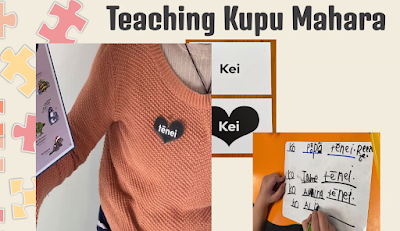Don't use 'who', 'which' - that makes it a clause.
Tēnā koutou e te whānau. Ko Rovena Jackson ahau. He kaiako ahau ki Te Māhuri Mānuka, Hornby Primary School ki Ōtautahi, Aotearoa. Ko te piko o te Māhuri, tērā te tipu o te rakau! Some background - A polynesian teacher, working in an akomanga reorua (a bilingual environment), contributing to a digitally savvy school, within an ultimately pakeha education system. Aue! This is my space to mull over education from a possibly not so common perspective.
Monday, November 25, 2024
Structured Literacy - Teaching writing through a SL lens - Wednesday 20th + Monday 25th November
Don't use 'who', 'which' - that makes it a clause.
Wednesday, November 20, 2024
Mahi by Mahi with Mahina Selby - Session 2
Kaupae 1 + 2 are a mix of stretchy and stop sounds.

nahanaha - systematic
raupapa - sequential
mataaho - explicit
kohura - diagnostic
"Tinihia te .... ki te ...." = for Heggarty
oro puare rua - sounds can still be separated
- Show pikitia of seomthing, eg kōtiro. He aha te kūoro tuatahi/whakamutunga?
- Use lego blocks for stretching out oro or kūoro
- Kupu Panga (guess the word) - show pikitia of 4 things, each thing beginning with the first pū of the kupu tamariki are trying to guess. eg. Hipi, Aniwawa, Kāmeta, Anuhe = HAKA
Wednesday, October 23, 2024
Structured Literacy - Teaching writing through a SL lens - Wednesday 23rd October
Asking Questions
Basic Conjunctions
Because - why (asking for more) (Sub-ord)
Give the stem - children finish the sentence.
Tuesday, October 15, 2024
Structured Literacy
Practice makes permanent!
REVLOC = trumping system
For something to be orthographically mapped - it might take 4-14 exposures. If the child is a neurodivergent learner, could be 200 exposures needed!
Mahi by Mahi with Mahina Selby - Session 1
Structured Literacy i te reo Māori
Cognitive Load Theory
Short Term Memory - Limited capacity, small duration - 5-7 items, 15-30 seconds.
Wednesday, October 9, 2024
Structured Literacy - Teaching writing through a SL lens - Wednesday 9th October
Module 1 : Laying the Foundation
- Writing should be taught using direct and explicit instruction and involve deliberate practice. I do, we do, you do. Appeal to the learner's brain. Hear, see, and say - model in every session. Let them hear teacher thought processes, lots from their peers. Let them see docs, responses on board. Let them say.
- Boost teacher knowledge of what to teach using a scope + sequence. text generation (words, sentences, and discourse), transcription (handwriting, keyboarding and spelling), and executive functioning (attention, planning, reviewing and self reg). Cover the writing rope.
- Sentences are the building blocks of writing, and grammar is best taught in the context of student writing.
- Content of the curriculum drives the rigour of the writing activities.
- Planning and revising important parts of the writing process.
- The importance of reg feedback, writing goals and assessing student writing.
- Embed through all subject areas and in the context of the curriculum you are teaching.
Module 2 : Transcription skills
Handwriting - cursive is good for kids who struggle to handwrite.
We want the bottom 2 to be at a level of automaticity.
Keyboarding could become an independent activity during your reading rotation: https://www.typingclub.com
Module 3 - Text Generation - Building blocks of writing
Syntax - ...the system and arrangements of words, phrases, and clauses that make up a sentence....
Independent clause - contain a sub + pred and can stand by them selves.
Dependent clause - contain both, but can not stand by themselves.
Friday, August 23, 2024
Structured Literacy - Unpacking the top half of Scarborough’s Reading Rope - Week 5 ~ Term 3 2024

Background Knowledge - facts, concepts etc…
Students’ knowledge of words and the world.
Prior knowledge helps make connections to the text.
Explicit teaching of background knowledge - link to prior knowledge, explicitly teach new knowledge that you want everyone to have.
Knowledge organizer - you can add background knowledge you have acquired the day before!
1 text = 4 sessions
‘Stretch text’ - a text that is pitched to the higher end of your class.
The text needs to do the heavy lifting - critical thinking, content knowledge, vocab, engagement!
Cool facts!
Vocabulary
Knowledge of a word, not only it’s definition but how it fits in the world.
Which vocab to teach? Tier 1 = high frequency words, Tier 2 - High freq in text, low in spoken conversation, Tier 3 - Academic vocab. We want to select words from Tier 2 - academic vocabulary used across curriculum areas, language of learning.
Word families - eg. Gleam, gleaming, gleamed.
Opportunity to look at nuances. Eg. gleam = a cat’s eyes.
Word associations - I choose … because …
Language Structure
Turning words into a sentence, how words are put together to make the sentence.
Colourful semantics! Subject + predicate.
Do it orally in junior classes - eg “This workshop is beneficial because…” and “This workshop was beneficial but…”
Syntax activity - is it a fragment or a sentence? Follow up task - finish the fragment!
Activities using practise of conjunctions - eg. because, but, so.
Think about the main idea you want to get across, rather than pulling out a sentence.Anticipations are necessary!
Verbal Reasoning
How a person works with words to get the real meaning.
Verbal reasoning skills will depend on a student’s background knowledge and vocabulary knowledge.
Inference, idioms, similes.
Local inference - eg ability to link subject to pronoun + global inference. “Katy dropped the vase. Se ran for the broom.”
Figurative language - don’t teach in isolation.
Pause points - purposeful questions and prompts that will activate prior knowledge, build subject knowledge, and encourage deeper understanding. Select points in the text.
Literacy Knowledge
Includes print awareness and knowledge of genres.
Investigate text features of non-fiction texts.
“This is a non-fiction article. I know this because…”




















































